SQLdiag-配置文件-PerfmonCollector
前一篇我们已经使用默认配置文件收集了部分诊断数据,并且知道配置文件会影响收集数据的内容。这一篇我们重点讲述配置文件中与性能计数器相关的操作。
可使用XML模板控制SQLdiag使用的收集器。每个收集器可以使用配置文件的<enabled="true">或<enabled="false">来启用或禁用。使用自己最喜欢的文件编辑器,甚至在支持XML文档编辑的Management Studio中修改XML配置文件。不要从XML文件中删除收集器,因为如果XML文件不能匹配,随后SQLdiag将不能加载XSD。
首先让我们使用SD_Detailed.XML配置文件收集5分钟数据:
cd D:\Program Files\Microsoft SQL Server\\Tools\Binn\
SQLdiag /I F:\TroubleShooting\SQLdiag\input\SD_Detailed.XML /O F:\TroubleShooting\SQLdiag\LocalOutput /E +::
生成的文件如下: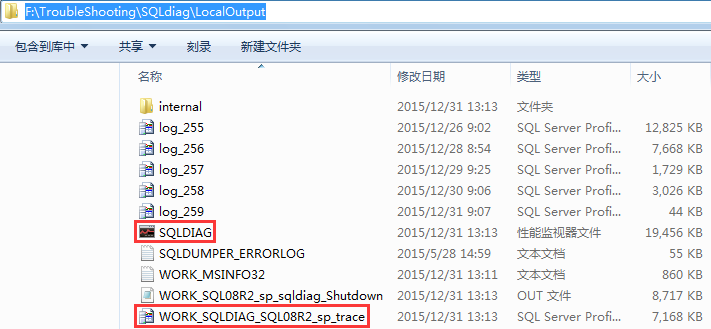
SQLDIAG:收集PerfMon数据,对应PerfmonCollector元素
WORK_SQLDIAG_SQL08R2_sp_trace:收集的跟踪数据,对应ProfilerCollector元素
其他文件的说明见上一篇,在我本地收集5分钟性能监视器文件达到19Mb、跟踪数据文件为7Mb(没有做任何其他操作)。
性能计数器数据,与收集计数器数量、轮询时间间隔有关。与收集时长是线性增长关系。
跟踪数据,与添加的跟踪事件,系统繁忙程度有关。收集的大小可能不成比例地膨胀。
建议在高峰时段短暂地运行SQLdiag约10-15分钟,来估计Profiler跟踪事件的生成率和耗费的磁盘空间。这使你能够在数据被改写之前,对将要捕获的活动的时间跨度形成一个粗略的近似。PerfMon文件并不像Profiler跟踪文件一样迅速地增大。Profiler跟踪收集到目前为止是SQLdiag中最消耗资源的数据收集组件。
PerfmonCollector
虽说收集PerfMon数据的开销相比其他数据收集器是最低的,但也不必要将所有性能计数据器都启用。本节将按照下面步骤测试:
1>禁用EventlogCollector、BlockingCollector、ProfilerCollector、CustomDiagnostics元素收集器;PerfmonCollector、SqldiagCollector元素保持启用
2>参照之前配置的数据收集器模板PerfmonLine启用/禁用PerfmonCollector元素下对应的计数器
<?xml version="1.0" encoding="UTF-16"?>
<DataCollectorSet>
<Status>1</Status>
<Duration>86100</Duration>
<Description>
</Description>
<DescriptionUnresolved>
</DescriptionUnresolved>
<DisplayName>
</DisplayName>
<DisplayNameUnresolved>
</DisplayNameUnresolved>
<SchedulesEnabled>-1</SchedulesEnabled>
<LatestOutputLocation>D:\Perfmon\DataCollector</LatestOutputLocation>
<Name>PLAYER</Name>
<OutputLocation>D:\Perfmon\DataCollector</OutputLocation>
<RootPath>D:\Perfmon</RootPath>
<Segment>0</Segment>
<SegmentMaxDuration>0</SegmentMaxDuration>
<SegmentMaxSize>0</SegmentMaxSize>
<SerialNumber>15</SerialNumber>
<Server>
</Server>
<Subdirectory>DataCollector</Subdirectory>
<SubdirectoryFormat>1</SubdirectoryFormat>
<SubdirectoryFormatPattern>
</SubdirectoryFormatPattern>
<Task>
</Task>
<TaskRunAsSelf>0</TaskRunAsSelf>
<TaskArguments>
</TaskArguments>
<TaskUserTextArguments>
</TaskUserTextArguments>
<UserAccount>SYSTEM</UserAccount>
<Security>O:BAG:S-1-5-21-2109620463-1702659591-2666464273-513D:AI(A;;FA;;;SY)(A;;FA;;;BA)(A;;FR;;;LU)(A;;0x1301ff;;;S-1-5-80-2661322625-712705077-2999183737-3043590567-590698655)(A;ID;FA;;;SY)(A;ID;FA;;;BA)(A;ID;0x1200ab;;;LU)(A;ID;FR;;;AU)(A;ID;FR;;;LS)(A;ID;FR;;;NS)</Security>
<StopOnCompletion>0</StopOnCompletion>
<PerformanceCounterDataCollector>
<DataCollectorType>0</DataCollectorType>
<Name>DataCollector</Name>
<FileName>PLAYER</FileName>
<FileNameFormat>1</FileNameFormat>
<FileNameFormatPattern>\-yyyyMMdd</FileNameFormatPattern>
<LogAppend>0</LogAppend>
<LogCircular>0</LogCircular>
<LogOverwrite>0</LogOverwrite>
<LatestOutputLocation>D:\Perfmon\DataCollector\PLAYER-20151105.blg</LatestOutputLocation>
<DataSourceName>
</DataSourceName>
<SampleInterval>30</SampleInterval>
<SegmentMaxRecords>0</SegmentMaxRecords>
<LogFileFormat>3</LogFileFormat>
<Counter>\Memory\Available MBytes</Counter>
<Counter>\Memory\Cache Bytes</Counter>
<Counter>\Memory\Commit Limit</Counter>
<Counter>\Memory\Committed Bytes</Counter>
<Counter>\Memory\Free System Page Table Entries</Counter>
<Counter>\Memory\Pages Input/sec</Counter>
<Counter>\Memory\Pages/sec</Counter>
<Counter>\Memory\System Cache Resident Bytes</Counter>
<Counter>\MSSQL$PLAYER:Access Methods\FreeSpace Scans/sec</Counter>
<Counter>\MSSQL$PLAYER:Access Methods\Full Scans/sec</Counter>
<Counter>\MSSQL$PLAYER:Access Methods\Table Lock Escalations/sec</Counter>
<Counter>\MSSQL$PLAYER:Access Methods\Worktables Created/sec</Counter>
<Counter>\MSSQL$PLAYER:Access Methods\Worktables From Cache Ratio</Counter>
<Counter>\MSSQL$PLAYER:Buffer Manager\Buffer cache hit ratio</Counter>
<Counter>\MSSQL$PLAYER:Buffer Manager\Checkpoint pages/sec</Counter>
<Counter>\MSSQL$PLAYER:Buffer Manager\Database pages</Counter>
<Counter>\MSSQL$PLAYER:Buffer Manager\Free list stalls/sec</Counter>
<Counter>\MSSQL$PLAYER:Buffer Manager\Free pages</Counter>
<Counter>\MSSQL$PLAYER:Buffer Manager\Lazy writes/sec</Counter>
<Counter>\MSSQL$PLAYER:Buffer Manager\Page life expectancy</Counter>
<Counter>\MSSQL$PLAYER:Buffer Manager\Page lookups/sec</Counter>
<Counter>\MSSQL$PLAYER:Buffer Manager\Page reads/sec</Counter>
<Counter>\MSSQL$PLAYER:Buffer Manager\Page writes/sec</Counter>
<Counter>\MSSQL$PLAYER:Buffer Manager\Readahead pages/sec</Counter>
<Counter>\MSSQL$PLAYER:Buffer Manager\Stolen pages</Counter>
<Counter>\MSSQL$PLAYER:Buffer Manager\Target pages</Counter>
<Counter>\MSSQL$PLAYER:Buffer Manager\Total pages</Counter>
<Counter>\MSSQL$PLAYER:Databases(_Total)\Transactions/sec</Counter>
<Counter>\MSSQL$PLAYER:General Statistics\Connection Reset/sec</Counter>
<Counter>\MSSQL$PLAYER:General Statistics\Logins/sec</Counter>
<Counter>\MSSQL$PLAYER:General Statistics\Logouts/sec</Counter>
<Counter>\MSSQL$PLAYER:General Statistics\Processes blocked</Counter>
<Counter>\MSSQL$PLAYER:General Statistics\User Connections</Counter>
<Counter>\MSSQL$PLAYER:Latches\Average Latch Wait Time (ms)</Counter>
<Counter>\MSSQL$PLAYER:Latches\Latch Waits/sec</Counter>
<Counter>\MSSQL$PLAYER:Latches\Total Latch Wait Time (ms)</Counter>
<Counter>\MSSQL$PLAYER:Locks(_Total)\Average Wait Time (ms)</Counter>
<Counter>\MSSQL$PLAYER:Locks(_Total)\Lock Requests/sec</Counter>
<Counter>\MSSQL$PLAYER:Locks(_Total)\Lock Timeouts (timeout > 0)/sec</Counter>
<Counter>\MSSQL$PLAYER:Locks(_Total)\Lock Timeouts/sec</Counter>
<Counter>\MSSQL$PLAYER:Locks(_Total)\Lock Wait Time (ms)</Counter>
<Counter>\MSSQL$PLAYER:Locks(_Total)\Lock Waits/sec</Counter>
<Counter>\MSSQL$PLAYER:Locks(_Total)\Number of Deadlocks/sec</Counter>
<Counter>\MSSQL$PLAYER:Memory Manager\Granted Workspace Memory (KB)</Counter>
<Counter>\MSSQL$PLAYER:Memory Manager\Maximum Workspace Memory (KB)</Counter>
<Counter>\MSSQL$PLAYER:Memory Manager\Memory Grants Outstanding</Counter>
<Counter>\MSSQL$PLAYER:Memory Manager\Memory Grants Pending</Counter>
<Counter>\MSSQL$PLAYER:Memory Manager\Stolen Server Memory (KB)</Counter>
<Counter>\MSSQL$PLAYER:Memory Manager\Target Server Memory (KB)</Counter>
<Counter>\MSSQL$PLAYER:Memory Manager\Total Server Memory (KB)</Counter>
<Counter>\MSSQL$PLAYER:Plan Cache(_Total)\Cache Hit Ratio</Counter>
<Counter>\MSSQL$PLAYER:SQL Statistics\Auto-Param Attempts/sec</Counter>
<Counter>\MSSQL$PLAYER:SQL Statistics\Batch Requests/sec</Counter>
<Counter>\MSSQL$PLAYER:SQL Statistics\Failed Auto-Params/sec</Counter>
<Counter>\MSSQL$PLAYER:SQL Statistics\Safe Auto-Params/sec</Counter>
<Counter>\MSSQL$PLAYER:SQL Statistics\SQL Compilations/sec</Counter>
<Counter>\MSSQL$PLAYER:SQL Statistics\SQL Re-Compilations/sec</Counter>
<Counter>\MSSQL$PLAYER:SQL Statistics\Unsafe Auto-Params/sec</Counter>
<Counter>\MSSQL$PLAYER:Transactions\Longest Transaction Running Time</Counter>
<Counter>\Network Interface(*)\Bytes Sent/sec</Counter>
<Counter>\Paging File(_Total)\% Usage Peak</Counter>
<Counter>\Paging File(_Total)\% Usage</Counter>
<Counter>\PhysicalDisk(1 D:)\% Idle Time</Counter>
<Counter>\PhysicalDisk(1 D:)\Avg. Disk Queue Length</Counter>
<Counter>\PhysicalDisk(1 D:)\Avg. Disk sec/Read</Counter>
<Counter>\PhysicalDisk(1 D:)\Avg. Disk sec/Transfer</Counter>
<Counter>\PhysicalDisk(1 D:)\Avg. Disk sec/Write</Counter>
<Counter>\PhysicalDisk(1 D:)\Disk Bytes/sec</Counter>
<Counter>\PhysicalDisk(1 D:)\Disk Reads/sec</Counter>
<Counter>\PhysicalDisk(1 D:)\Disk Writes/sec</Counter>
<Counter>\Process(sqlservr)\% Processor Time</Counter>
<Counter>\Process(sqlservr)\Private Bytes</Counter>
<Counter>\Process(sqlservr)\% User Time</Counter>
<Counter>\Processor(_Total)\% Privileged Time</Counter>
<Counter>\Processor(_Total)\% Processor Time</Counter>
<Counter>\Processor(_Total)\% User Time</Counter>
<Counter>\System\Context Switches/sec</Counter>
<Counter>\System\Processor Queue Length</Counter>
<CounterDisplayName>\Memory\Available MBytes</CounterDisplayName>
<CounterDisplayName>\Memory\Cache Bytes</CounterDisplayName>
<CounterDisplayName>\Memory\Commit Limit</CounterDisplayName>
<CounterDisplayName>\Memory\Committed Bytes</CounterDisplayName>
<CounterDisplayName>\Memory\Free System Page Table Entries</CounterDisplayName>
<CounterDisplayName>\Memory\Pages Input/sec</CounterDisplayName>
<CounterDisplayName>\Memory\Pages/sec</CounterDisplayName>
<CounterDisplayName>\Memory\System Cache Resident Bytes</CounterDisplayName>
<CounterDisplayName>\MSSQL$PLAYER:Access Methods\FreeSpace Scans/sec</CounterDisplayName>
<CounterDisplayName>\MSSQL$PLAYER:Access Methods\Full Scans/sec</CounterDisplayName>
<CounterDisplayName>\MSSQL$PLAYER:Access Methods\Table Lock Escalations/sec</CounterDisplayName>
<CounterDisplayName>\MSSQL$PLAYER:Access Methods\Worktables Created/sec</CounterDisplayName>
<CounterDisplayName>\MSSQL$PLAYER:Access Methods\Worktables From Cache Ratio</CounterDisplayName>
<CounterDisplayName>\MSSQL$PLAYER:Buffer Manager\Buffer cache hit ratio</CounterDisplayName>
<CounterDisplayName>\MSSQL$PLAYER:Buffer Manager\Checkpoint pages/sec</CounterDisplayName>
<CounterDisplayName>\MSSQL$PLAYER:Buffer Manager\Database pages</CounterDisplayName>
<CounterDisplayName>\MSSQL$PLAYER:Buffer Manager\Free list stalls/sec</CounterDisplayName>
<CounterDisplayName>\MSSQL$PLAYER:Buffer Manager\Free pages</CounterDisplayName>
<CounterDisplayName>\MSSQL$PLAYER:Buffer Manager\Lazy writes/sec</CounterDisplayName>
<CounterDisplayName>\MSSQL$PLAYER:Buffer Manager\Page life expectancy</CounterDisplayName>
<CounterDisplayName>\MSSQL$PLAYER:Buffer Manager\Page lookups/sec</CounterDisplayName>
<CounterDisplayName>\MSSQL$PLAYER:Buffer Manager\Page reads/sec</CounterDisplayName>
<CounterDisplayName>\MSSQL$PLAYER:Buffer Manager\Page writes/sec</CounterDisplayName>
<CounterDisplayName>\MSSQL$PLAYER:Buffer Manager\Readahead pages/sec</CounterDisplayName>
<CounterDisplayName>\MSSQL$PLAYER:Buffer Manager\Stolen pages</CounterDisplayName>
<CounterDisplayName>\MSSQL$PLAYER:Buffer Manager\Target pages</CounterDisplayName>
<CounterDisplayName>\MSSQL$PLAYER:Buffer Manager\Total pages</CounterDisplayName>
<CounterDisplayName>\MSSQL$PLAYER:Databases(_Total)\Transactions/sec</CounterDisplayName>
<CounterDisplayName>\MSSQL$PLAYER:General Statistics\Connection Reset/sec</CounterDisplayName>
<CounterDisplayName>\MSSQL$PLAYER:General Statistics\Logins/sec</CounterDisplayName>
<CounterDisplayName>\MSSQL$PLAYER:General Statistics\Logouts/sec</CounterDisplayName>
<CounterDisplayName>\MSSQL$PLAYER:General Statistics\Processes blocked</CounterDisplayName>
<CounterDisplayName>\MSSQL$PLAYER:General Statistics\User Connections</CounterDisplayName>
<CounterDisplayName>\MSSQL$PLAYER:Latches\Average Latch Wait Time (ms)</CounterDisplayName>
<CounterDisplayName>\MSSQL$PLAYER:Latches\Latch Waits/sec</CounterDisplayName>
<CounterDisplayName>\MSSQL$PLAYER:Latches\Total Latch Wait Time (ms)</CounterDisplayName>
<CounterDisplayName>\MSSQL$PLAYER:Locks(_Total)\Average Wait Time (ms)</CounterDisplayName>
<CounterDisplayName>\MSSQL$PLAYER:Locks(_Total)\Lock Requests/sec</CounterDisplayName>
<CounterDisplayName>\MSSQL$PLAYER:Locks(_Total)\Lock Timeouts (timeout > 0)/sec</CounterDisplayName>
<CounterDisplayName>\MSSQL$PLAYER:Locks(_Total)\Lock Timeouts/sec</CounterDisplayName>
<CounterDisplayName>\MSSQL$PLAYER:Locks(_Total)\Lock Wait Time (ms)</CounterDisplayName>
<CounterDisplayName>\MSSQL$PLAYER:Locks(_Total)\Lock Waits/sec</CounterDisplayName>
<CounterDisplayName>\MSSQL$PLAYER:Locks(_Total)\Number of Deadlocks/sec</CounterDisplayName>
<CounterDisplayName>\MSSQL$PLAYER:Memory Manager\Granted Workspace Memory (KB)</CounterDisplayName>
<CounterDisplayName>\MSSQL$PLAYER:Memory Manager\Maximum Workspace Memory (KB)</CounterDisplayName>
<CounterDisplayName>\MSSQL$PLAYER:Memory Manager\Memory Grants Outstanding</CounterDisplayName>
<CounterDisplayName>\MSSQL$PLAYER:Memory Manager\Memory Grants Pending</CounterDisplayName>
<CounterDisplayName>\MSSQL$PLAYER:Memory Manager\Stolen Server Memory (KB)</CounterDisplayName>
<CounterDisplayName>\MSSQL$PLAYER:Memory Manager\Target Server Memory (KB)</CounterDisplayName>
<CounterDisplayName>\MSSQL$PLAYER:Memory Manager\Total Server Memory (KB)</CounterDisplayName>
<CounterDisplayName>\MSSQL$PLAYER:Plan Cache(_Total)\Cache Hit Ratio</CounterDisplayName>
<CounterDisplayName>\MSSQL$PLAYER:SQL Statistics\Auto-Param Attempts/sec</CounterDisplayName>
<CounterDisplayName>\MSSQL$PLAYER:SQL Statistics\Batch Requests/sec</CounterDisplayName>
<CounterDisplayName>\MSSQL$PLAYER:SQL Statistics\Failed Auto-Params/sec</CounterDisplayName>
<CounterDisplayName>\MSSQL$PLAYER:SQL Statistics\Safe Auto-Params/sec</CounterDisplayName>
<CounterDisplayName>\MSSQL$PLAYER:SQL Statistics\SQL Compilations/sec</CounterDisplayName>
<CounterDisplayName>\MSSQL$PLAYER:SQL Statistics\SQL Re-Compilations/sec</CounterDisplayName>
<CounterDisplayName>\MSSQL$PLAYER:SQL Statistics\Unsafe Auto-Params/sec</CounterDisplayName>
<CounterDisplayName>\MSSQL$PLAYER:Transactions\Longest Transaction Running Time</CounterDisplayName>
<CounterDisplayName>\Network Interface(*)\Bytes Sent/sec</CounterDisplayName>
<CounterDisplayName>\Paging File(_Total)\% Usage Peak</CounterDisplayName>
<CounterDisplayName>\Paging File(_Total)\% Usage</CounterDisplayName>
<CounterDisplayName>\PhysicalDisk(1 D:)\% Idle Time</CounterDisplayName>
<CounterDisplayName>\PhysicalDisk(1 D:)\Avg. Disk Queue Length</CounterDisplayName>
<CounterDisplayName>\PhysicalDisk(1 D:)\Avg. Disk sec/Read</CounterDisplayName>
<CounterDisplayName>\PhysicalDisk(1 D:)\Avg. Disk sec/Transfer</CounterDisplayName>
<CounterDisplayName>\PhysicalDisk(1 D:)\Avg. Disk sec/Write</CounterDisplayName>
<CounterDisplayName>\PhysicalDisk(1 D:)\Disk Bytes/sec</CounterDisplayName>
<CounterDisplayName>\PhysicalDisk(1 D:)\Disk Reads/sec</CounterDisplayName>
<CounterDisplayName>\PhysicalDisk(1 D:)\Disk Writes/sec</CounterDisplayName>
<CounterDisplayName>\Process(sqlservr)\% Processor Time</CounterDisplayName>
<CounterDisplayName>\Process(sqlservr)\Private Bytes</CounterDisplayName>
<CounterDisplayName>\Process(sqlservr)\% User Time</CounterDisplayName>
<CounterDisplayName>\Processor(_Total)\% Privileged Time</CounterDisplayName>
<CounterDisplayName>\Processor(_Total)\% Processor Time</CounterDisplayName>
<CounterDisplayName>\Processor(_Total)\% User Time</CounterDisplayName>
<CounterDisplayName>\System\Context Switches/sec</CounterDisplayName>
<CounterDisplayName>\System\Processor Queue Length</CounterDisplayName>
</PerformanceCounterDataCollector>
<Schedule>
<StartDate>5/20/2015</StartDate>
<EndDate>11/14/2015</EndDate>
<StartTime>9:30:00 AM</StartTime>
<Days>127</Days>
</Schedule>
<DataManager>
<Enabled>0</Enabled>
<CheckBeforeRunning>0</CheckBeforeRunning>
<MinFreeDisk>0</MinFreeDisk>
<MaxSize>0</MaxSize>
<MaxFolderCount>0</MaxFolderCount>
<ResourcePolicy>0</ResourcePolicy>
<ReportFileName>report.html</ReportFileName>
<RuleTargetFileName>report.xml</RuleTargetFileName>
<EventsFileName>
</EventsFileName>
</DataManager>
</DataCollectorSet>
注意对象下有多实例的情况,比如<PerfmonObject name="\Processor(*)" enabled="true">
它会收集Processor对象下指定计数器中所有实例的信息(包含_Total);在对象上的enabled="false"并不能禁用其下计数器的收集,必须显示在PerfmonCollector元素层或者底层计数器设置enabled="false"
很难一次将所有计数器调整成PerfmonLine模板所配置的,只有修改后让其收集性能计数器,然后查看收集的数据,如此反复几次。修改后收集的数据如下,图形中可能不会呈现出所有收集的计数器,我们可以右击将其他可用的计数器添加到面板。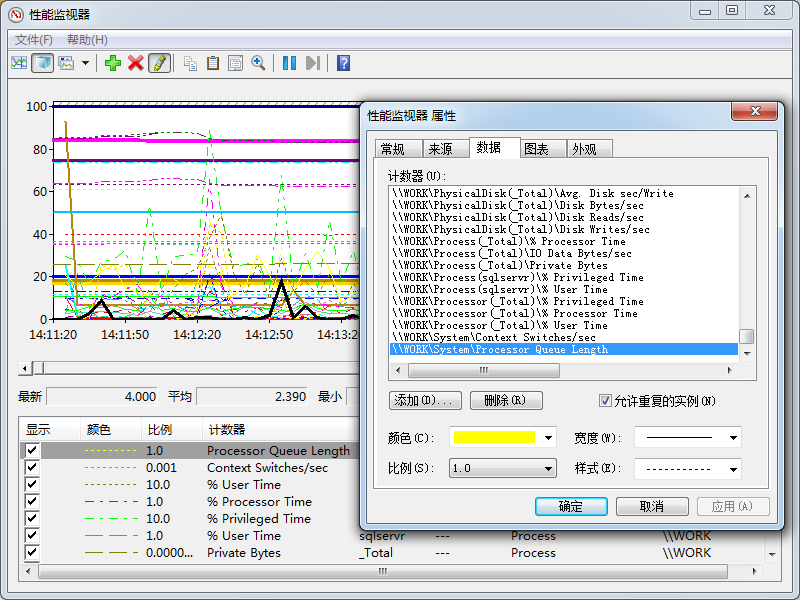
测试禁用对象<PerfmonObject name="\LogicalDisk(*)" enabled="false">,但其下的部分计数器是开启的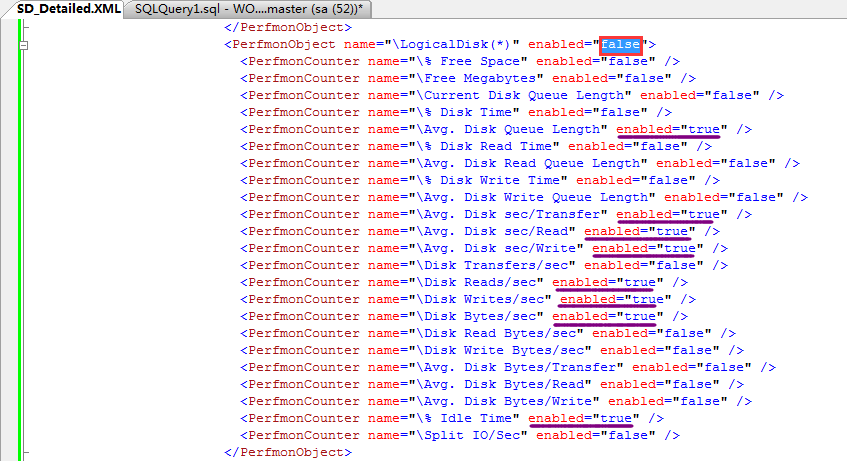
我们查看收集到的数据中还是有对应计数器,难道启用/禁用只有在顶层元素设置才会对其下的对象有影响?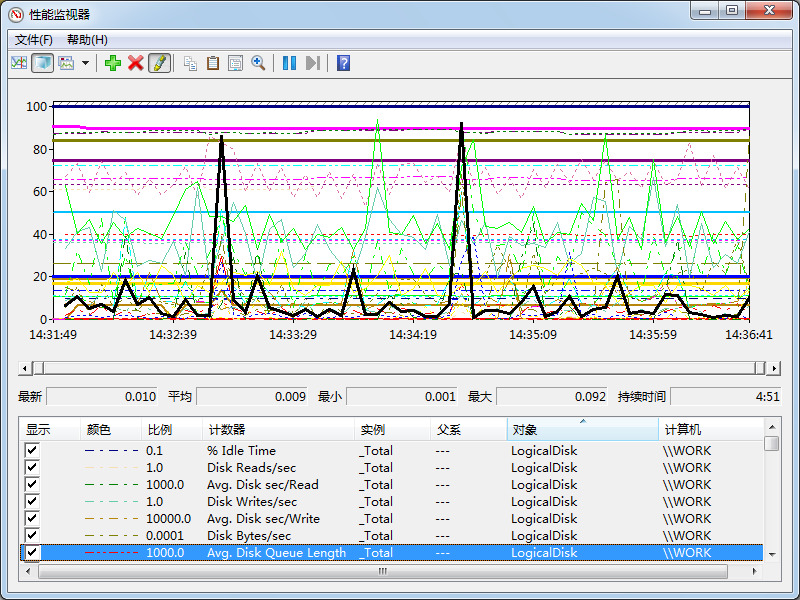
结合SQL Nexus完善PerfmonCollector的收集
我们使用sqlnexus导入收集的SQLdiag数据,我们主要查看Perfmon Summary,点击Perfmon Summary出现的页面几乎没数据!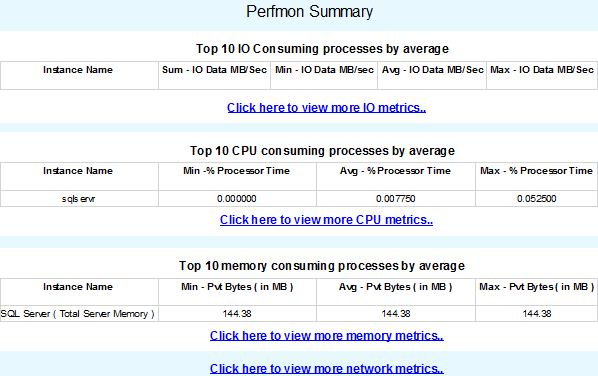
是否还记得我们在RML中有使用Proflier,查看RML所调用的过程/语句。此处我们也利用Proflier监控sqlnexus所调用的过程/语句(跟踪添加筛选器ApplicationName类似于sqlnexus)
我们重新点击Perfmon Summary,在Proflier跟踪下看到如下信息: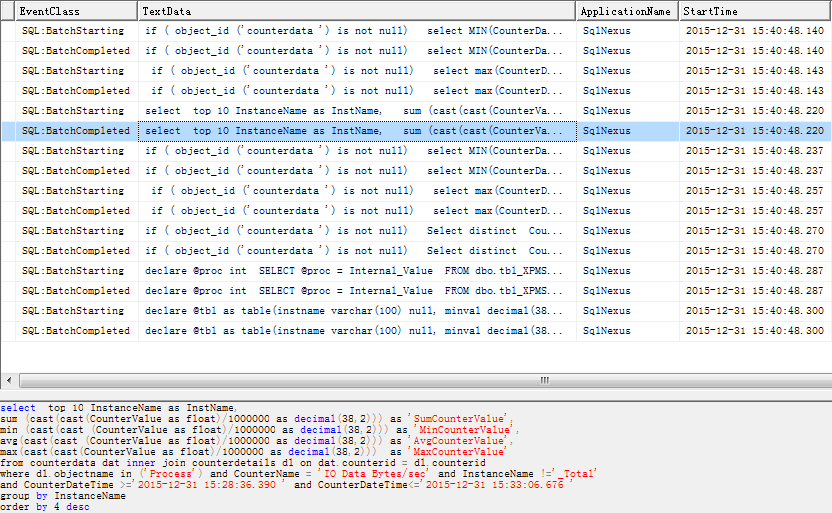
查看详细代码可知IO、CPU、Memory是来自下面计数器
<Counter>\Process(*)\IO Data Bytes/sec</Counter>
<Counter>\Process(*)\% Processor Time</Counter>
<Counter>\Process(*)\Private Bytes</Counter>
而这些计数器刚好没有收集(仅仅收集Process(sqlservr)一个实例)
点击 Click here to view more IO metrics..没有数据: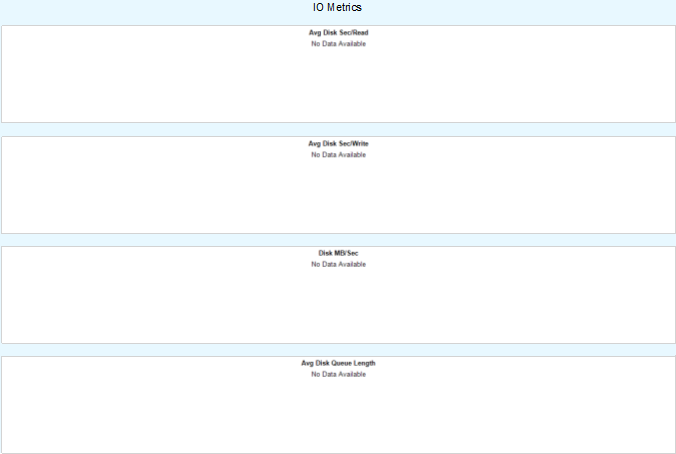
查看Proflier跟踪下看到如下信息: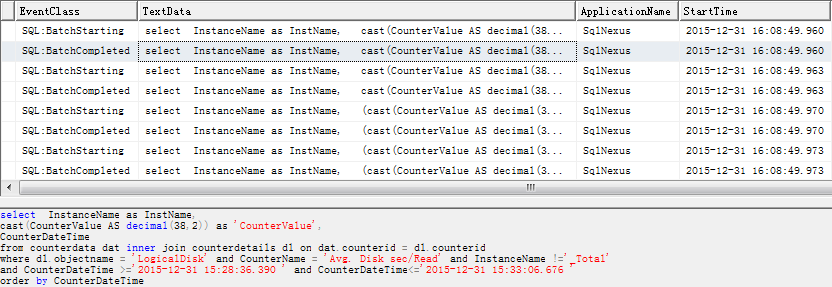
查看详细代码可知IO详细信息是来自下面计数器
<Counter>\LogicalDisk(*)\Avg. Disk sec/Read</Counter>
<Counter>\LogicalDisk(*)\Avg. Disk sec/Write</Counter>
<Counter>\LogicalDisk(*)\Disk Bytes/sec</Counter>
<Counter>\LogicalDisk(*)\Avg. Disk Queue Length</Counter>
点击Click here to view more CPU/Memory metrics..报错
查看Proflier跟踪下看到如下信息: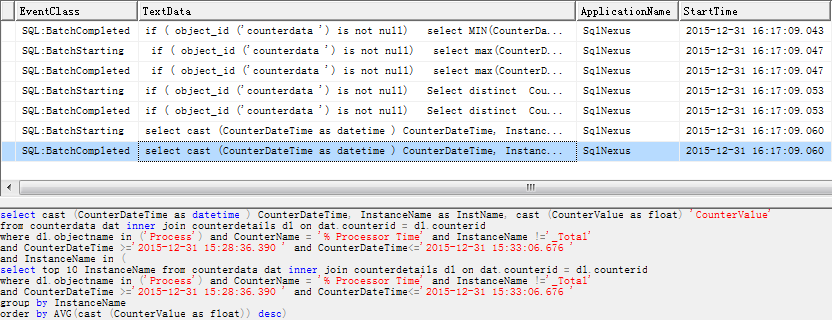
单独取语句到查询窗口执行,报错“从字符串转换日期和/或时间时,转换失败。”但将CounterDateTime截取再转就可以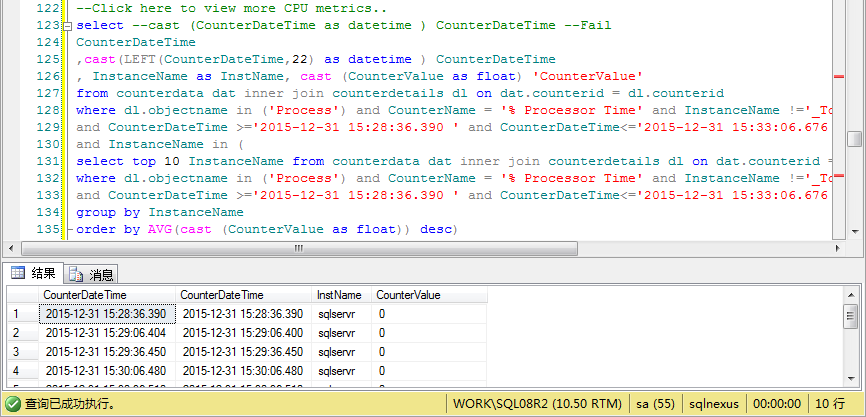
点击 Click here to view more Network metrics..没有数据:
查看Proflier跟踪下看到如下信息: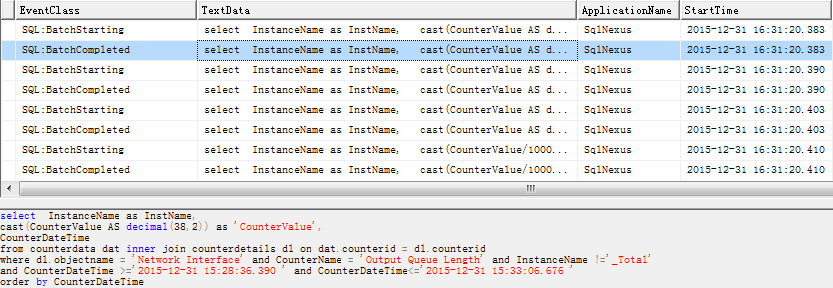
查看详细代码可知NetWork详细信息是来自下面计数器
<Counter>\Network Interface(*)\Output Queue Length</Counter>
<Counter>\Network Interface(*)\Packets Received Discarded</Counter>
<Counter>\Network Interface(*)\Packets Outbound Discarded</Counter>
<Counter>\Network Interface(*)\Bytes Total/Sec</Counter>
针对上面的问题,解决方案如下:
1>将上面列出的Process(*)、LogicalDisk(*)、Network Interface(*)相关计数器启用
2>使用如下语句更新CounterData中的CounterDateTime字段
USE sqlnexus
GO
UPDATE CounterData SET
CounterDateTime=LEFT(CounterDateTime,22)
导入数据时有跟踪到创建counterdata的脚本,但没找到原始建表语句保存在哪。另外在sqlnexus应用程序目录的PerfStatsAnalysis.sql文件中有对CounterData表的alter/update语句...
以上问题修正后,再次收集数据用sqlnexus工具查看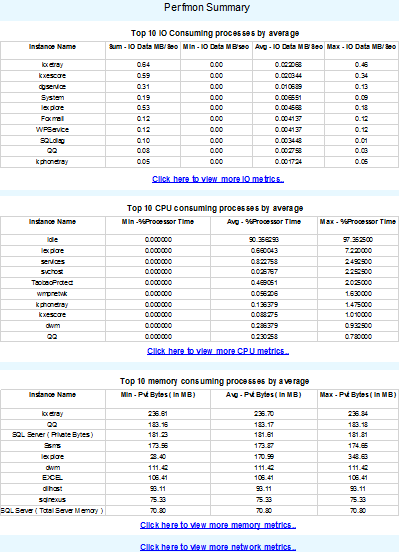
Perfmon Summary总界面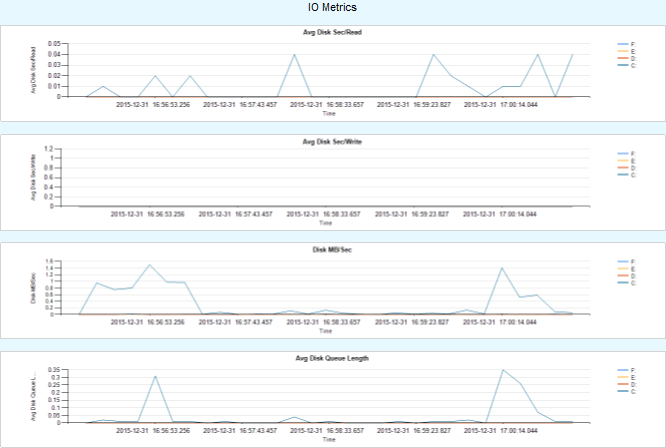
IO metrics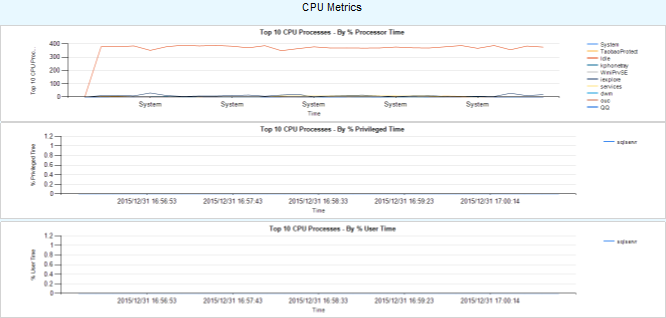
CPU metrics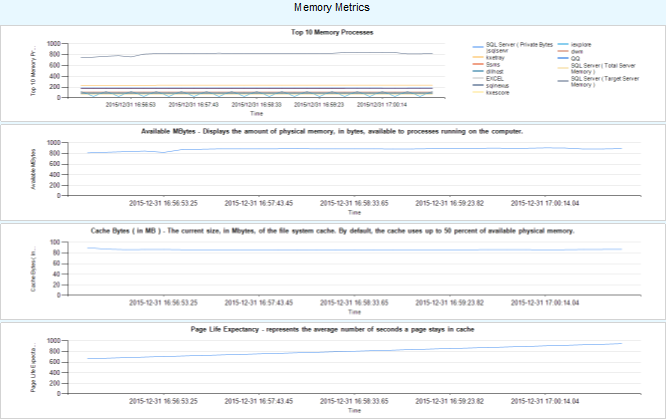
Memory metrics
NetWork metrics
我们可以针对每个图形跟踪其涉及的数据,并最终定位来自哪些计数器。如果已经启用相应的计数器,但是在图形中没有看到,就要查看展现的语句是如何处理的,sqlnexus会对部分数值进行单位换算(类似RML中的Scale)。当前SD_Detailed.XML配置文件的PerfmonCollector元素部分可参考文件链接对应部分。
SQLdiag-配置文件-PerfmonCollector的更多相关文章
- SQLdiag-初识
SQLdiag是一个命令行实用工具,默认情况下,在C:\Program Files\Microsoft SQL Server\100\Tools\Binn目录下可用.首先我们打开SQLdiag.exe ...
- SQLdiag Utility
使用SQLdiag 会进行信息搜集类型 Windows 系统性能日志 Windows 系统日志 SQL Server 性能信息 SQL Server 阻塞信息 SQL Server 配置信息 如何使用 ...
- 使用SQLdiag Utility搜集SQL Server诊断信息
SQLdiag Utility用于搜集诊断信息,给Microsoft技术支持人员做为判断依据. 使用SQLdiag 会进行信息搜集类型 Windows 系统性能日志 Windows 系统日志 SQL ...
- 【监控笔记】【1.4】Pssdiag和Sqldiag管理器
--没有实操过,有点复杂,先写上以后有用到再深入研究 统计与诊断数据是任何 SQL故障修复工作的关键所在. 如果没有掌握这些数据,就无法确定数据性能问题的根源.数据表的瓶颈可能并不是由索引问题造成的: ...
- .Net Core MVC 网站开发(Ninesky) 2.3、项目架构调整(续)-使用配置文件动态注入
上次实现了依赖注入,但是web项目必须要引用业务逻辑层和数据存储层的实现,项目解耦并不完全:另一方面,要同时注入业务逻辑层和数据访问层,注入的服务直接写在Startup中显得非常臃肿.理想的方式是,w ...
- ASP.NET MVC5+EF6+EasyUI 后台管理系统(64)-补充WebApi与Unity注入-配置文件
系列目录 上一篇演示了WebApi利用Unity注入 很多人问我如何用配置文件来配置注入,本节演示如何利用配置文件来注入,道理是一样的,跳转到上一节下载源码一起来动手! 1.打开源码定位到文件Depe ...
- Spring配置文件标签报错:The prefix "XXX" for element "XXX:XXX" is not bound. .
例如:The prefix "context" for element "context:annotation-config" is not bound. 这种 ...
- nginx服务器安装及配置文件详解
nginx在工作中已经有好几个环境在使用了,每次都是重新去网上扒博客,各种编译配置,今天自己也整理一份安装文档和nginx.conf配置选项的说明,留作以后参考.像负载均衡配置(包括健康检查).缓存( ...
- C#开发中使用配置文件对象简化配置的本地保存
C#开发中使用配置文件对象简化配置的本地保存 0x00 起因 程序的核心是数据和逻辑,开发过程中免不了要对操作的数据进行设置,而有些数据在程序执行过程中被用户或程序做出的修改是应该保存下来的,这样程序 ...
随机推荐
- 使用安捷伦波形编辑软件产生GK101 任意波数据文件的方法(支持手绘)
软件安装包下载地址: 链接: http://pan.baidu.com/s/1bn8Lmhx 密码: v5xz 一.安捷伦IO套件安装 1.将压缩包解压,首先双击IOLibSuite_16_3_179 ...
- 让apache不区分图片和文件后缀大小写
加载mod_speling模块: LoadModule speling_module /usr/lib/apache2/modules/mod_speling.so 开启模块: CheckSpelli ...
- Target runtime Apache Tomcat v6.0 is not defined
在工程目录下的.settings文件夹里,打开org.eclipse.wst.common.project.facet.core.xml文件,其内容是: <?xml version=" ...
- Web 在线文件管理器学习笔记与总结(5)修改文件内容
① 读出要修改的文件的内容 ② 进行修改 ③ 将修改后的内容写进文件 index.php: <?php require 'dir.func.php'; require 'file.func.ph ...
- 运维工程师必会的109个Linux命令
运维工程师必会的109个Linux命令 版本1.0 崔存新 更新于2009-12-26 目录 1 文件管理 6 1.1 basename 6 1.2 cat 6 1.3 cd 7 1.4 chgrp ...
- ExtJS笔记2 Class System
For the first time in its history, Ext JS went through a huge refactoring from the ground up with th ...
- Oracle 数据库安装
下载 www.oracle.com ->Downloads -> Oracle Database 安装: 解压到同一文件夹下 仅安装数据库软件 单实例数据库安装 企业版 oracle基目录 ...
- HTML: Css初始化
相同的元素, 如ul>li,body等元素在不同的瀏覽器下被渲染的效果不同(各個瀏覽器對這些元素的border,margin,padding,font-size等等的初始值不同), 要讓他們表現 ...
- 微信公众账号开发教程(一) 基本原理及微信公众账号注册 ——转自http://www.cnblogs.com/yank/p/3364827.html
微信公众账号开发教程 基本原理 在开始做之前,大家可能对这个很感兴趣,但是又比较茫然.是不是很复杂?很难学啊? 其实恰恰相反,很简单.为了打消大家的顾虑,先简单介绍了微信公众平台的基本原理. 微信服务 ...
- JNI字段描述符-Java Native Interface Field Descriptors
一.JNI字段描述符 "[I" --- int[] "[[[D" --- double[][][] 如果以一个L开头的描述符,就是类描述符,它后紧跟着类的字符 ...
